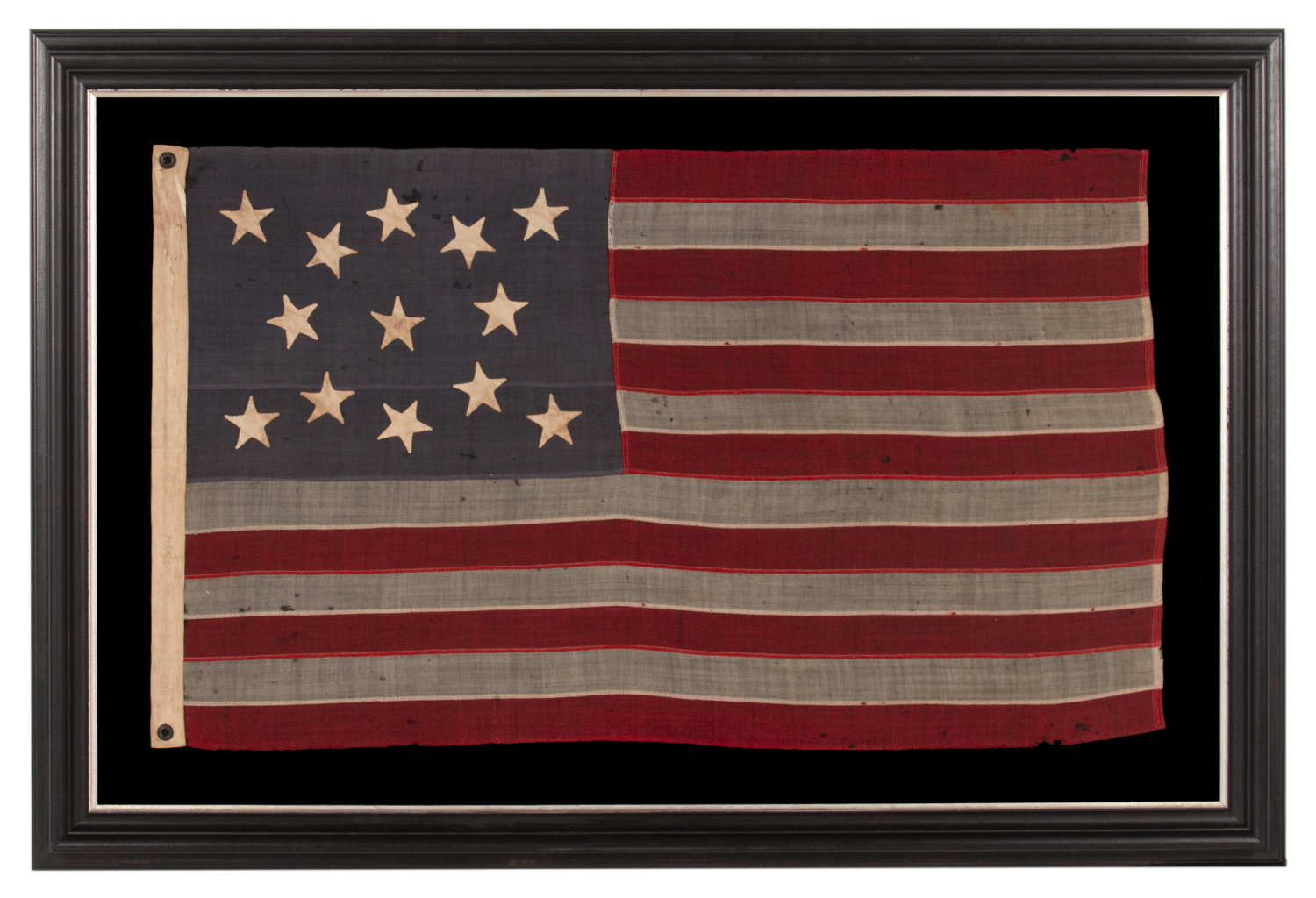
| |
13 STAR ANTIQUE AMERICAN FLAG, WITH A MEDALLION CONFIGURATION OF HAND-SEWN STARS ON A DUSTY BLUE CANTON, A SMALL-SCALE EXAMPLE OF THE LATE 19TH CENTURY |
|
| Available: |
Sold |
| Frame Size (H x L): |
39" x 57" |
| Flag Size (H x L): |
27.5" x 46.25" |
|
| Description....: |
|
13 star American national flag with hand-sewn stars and in an extremely small scale amongst its 19th century counterparts. The stars are arranged in a medallion pattern that features a wreath of 8 stars, surrounding a single, center star, with a flanking star in each corner. This design emerged during the Civil War and became very popular afterwards, especially on small, hand-held, printed flags, made for the 1876 celebration of our nation’s 100th anniversary.
The stars are made of cotton and are double-appliquéd (applied to both sides). The canton and stripes of the flag are made of wool bunting that has been pieced and joined with treadle stitching. There is a twill cotton binding along the hoist with 2 brass grommets. Along this, adjacent to the 5th red stripe, is a penciled inscription that reads “ 2 ½ x 4,” notating its size in feet.
Note how the coloration of the canton has faded to a dusty, stone blue. This is both an attractive feature and indicative of the flag’s date of manufacture. When this trait is present, it is most often encountered in flags that date between 1885 and 1895, and more often in the second half of that ten-year date bracket. The color is a result of what is known as a "fugitive" dye, which is one that breaks down chemically, of its own right, whether or not it has been exposed for prolonged periods to light. After 1895, either flag manufacturers caught on to the fugitive dye and ordered different wool, or the textile company that was producing it changed its dying process. In any event, flags that were made with this particular fabric and have survived to the present day, have an interesting presentation that many collectors find pleasing to the eye.
The small scale of the flag itself is very desirable. Prior to the last decade of the 19th century, most flags made for extended outdoor use were very large. Those with pieced-and-sewn construction were generally eight feet long and larger. This is because flags needed to be seen from a distance to be effective in their purpose as signals. Today their use is more often decorative and the general display of patriotism. Smaller flags exist in the early periods, but they are the exception. A six-foot example is small among flags of those that pre-date 1890, and they smaller they are, the rarer they are. Beginning around 1890. Flag-makers started producing 3- and 4-foot examples for the first time in quantity. These almost universally displayed 13 stars, emulating Navy use of 13 star flags on small craft.
Why 13 Stars?
13 star flags have been continuously produced throughout our nation’s history for purposes both patriotic and utilitarian. This was the original number of stars on the American flag, representing the original 13 colonies, so it was appropriate for any flag made in conjunction with celebrations of American independence. 13 star flags were hoisted at patriotic events, including Lafayette’s visit in 1824-25, the celebration of the nation’s centennial in 1876, and the sesquicentennial in 1926. They were displayed during the Civil War, to reference past struggles for American liberty and victory over oppression, and were used by 19th century politicians while campaigning for the same reason.
13 star flags were flown by American ships both private and federal. The U.S. Navy used 13 stars on the ensigns made for small boats, because they wished the stars to be easily discerned at a distance. As the number of stars grew with the addition of new states, it became more and more difficult to fit stars on a small flag so that they may be viewed from afar as individual objects. Because any star count that has previously been official remains so today according to the Congressional flag acts, all 13 star flags in an otherwise appropriate design remain official flags of the United States.
Due to a combination of the small scale of the flag, its hand-sewn stars, and the attractive visual qualities of both its star design and color, this is an excellent example among 13 star flags of the late 19th century.
Mounting: The flag was mounted and framed in our own textile conservation department, which is led by expert trained staff. We take great care in the mounting and preservation of flags and have framed thousands of examples. Feel free to contact us for more details.
The background is 100% cotton twill, black in color. The black-painted, hand-gilded and distressed molding is Italian. The glazing is U.V. protective Plexiglas.
Condition: There is minor mothing in the stripes in limited areas. There minor mothing in the canton, in addition to two areas of modest loss of the same, one above the top, center star and one near the top, hoist-end corner. There is modest to moderate soiling on the white hoist binding and in the stars. There is significant fading of the blue wool bunting, resulting from fugitive dye. Many of my clients prefer early flags to show their age and history of use. |
|
|
|
| Collector Level: |
Advanced Collectors and the Person with Everything |
|
| Flag Type: |
Sewn flag |
|
| Star Count: |
13 |
|
| Earliest Date of Origin: |
1889 |
|
| Latest Date of Origin: |
1895 |
|
| State/Affiliation: |
13 Original Colonies |
|
| War Association: |
|
|
| Price: |
SOLD |
|
| |
Views: 975 |
|
|
|

